Reading Time: 13 mins
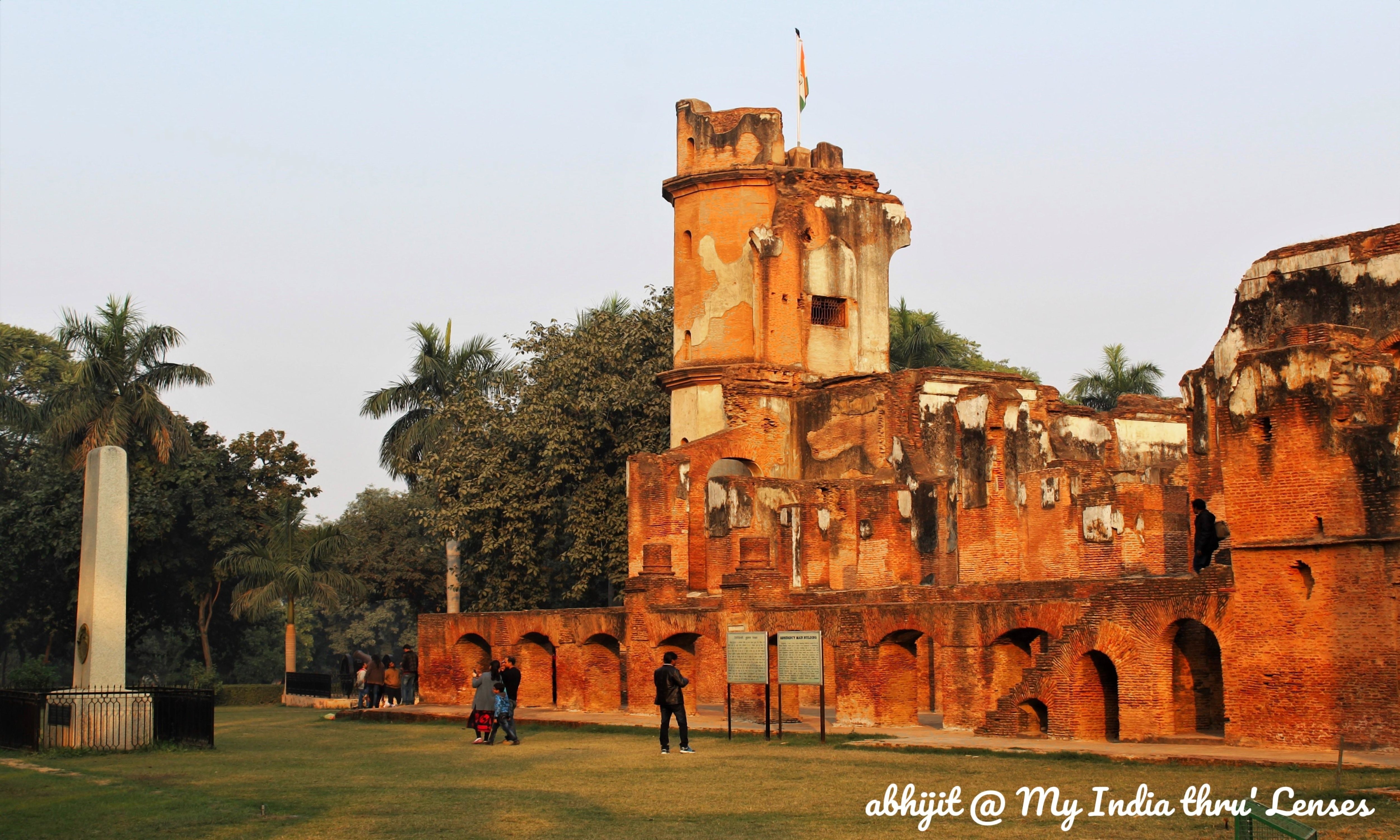
The British Residency (aka Lucknow Residency) was built during 1780 – 1800 by Nawab Asaf-ud-daulah to house the British Resident General in the court of Awadh. Within a short period of time, it became a large complex comprising several buildings including residential quarters, offices, armoury, stables, dispensaries, worship places and many more, virtually a British Settlement – a ‘City within the City’ of Lucknow. During the Sepoy Mutiny or India’s First War of Independence in 1857, the Residency Complex was under siege by the Indian soldiers for around 6 months. There were several fierce encounters in and around the Complex till the inhabitants were finally relieved followed by a brutal recapture of the City of Lucknow. The Residency was completely ruined and was never rebuilt. Today, in the Kaiser Bagh area, it stands as the silent witness of the 1857 revolution. Each & every brick of the ruined structures here speaks about the war fought, the valour shown and the pain suffered by the soldiers during the great uprise. The Article highlights, in short, the history of the City of Lucknow, the Residency and the siege followed by a photo-tour of the present-day Residency.
Lucknow, the capital of Uttar Pradesh, is famous for classic monuments of Islamic & British periods, charming bazaars, crowded streets and delicious cuisines. The city rose to its prominence in the late-18th century when it became the capital of province of Awadh (Oudh) in colonial India. The Nawabs of Awadh were great patrons of culinary and other arts, particularly dance & music. Quite obviously, the capital city Lucknow became the ‘City of Nawabs’ and earned huge reputation across the world for its culture, gracious living and rich cuisine. However, the independence of Awadh didn’t last for a very long time. With the expansion of British East India Company, Awadh slowly started losing its independence and finally the state was annexed to British Empire in 1856 when Nawab Wajid Ali Shah was deposed. One year later, in 1857 during the Sepoy Mutiny or India’s first war of Independence the city of Lucknow underwent mass slaughter, loot & brutal destruction at the hands of the British, which was one of the greatest tragedies of 19th century India. With that the grandiosity of Lucknow also faded. The city that the contemporary visitors used to compare with Vienna & Paris, could never regain its lost beauty.
Read full travelogue on Lucknow: Constantinople of India: Exploring the Historical City of Lucknow
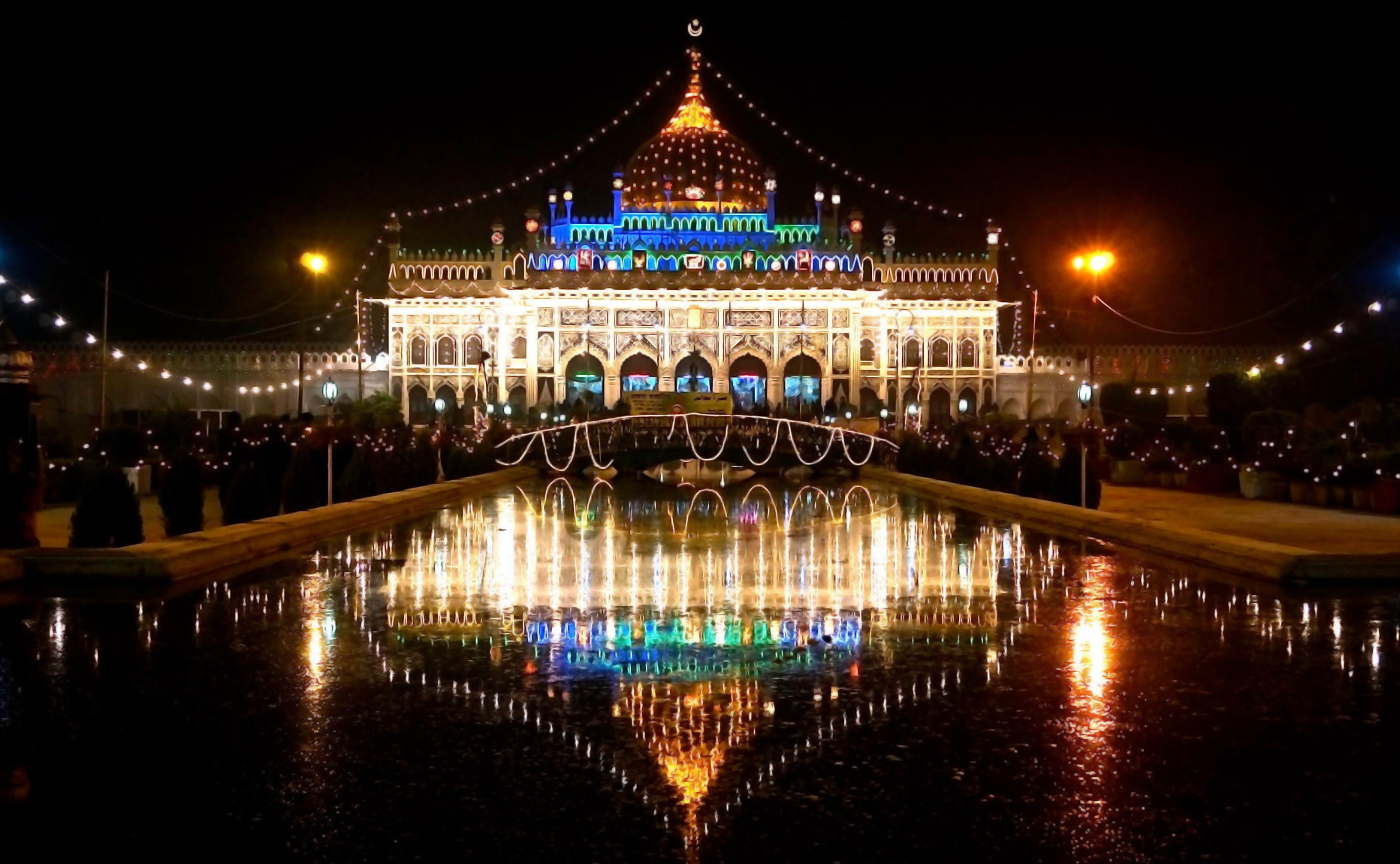
Under direct patronage of the Nawabs, literature, music, dance, culinary and other arts of ‘Lucknow Gharana’ became world famous. Several spectacular monuments were also built within the city. The city of Lucknow became ‘Golden City of the East’ and also the ‘Constantinople of India’. (Photo source: www.tehzeebelucknow.com)
EARLY HISTORY OF AWADH & ITS CAPITAL LUCKNOW
According to legend, Rama, after conquering Sri Lanka and completing his exile, gifted Lakshman a territory that became famous as Lakshmanpur, a suburb of the ancient metropolis of Ayodhya. It is believed that this Lakshmanpur is today’s Lucknow, which is at a distance of 130 kms from Ayodhya. What happened to the ancient metropolis of Ayodhya & its suburb Lakshmanpur remains largely unknown across a huge descent of time. Roughly 1000 years back, when Afghans conquered Kannauj, Awadh submitted to the Sultan of Ghazni. Later, by the end of 12th century it became part of Delhi Sultanate. Three centuries later in the Mughal period, Awadh declared its independence under a Muslim ruler for a very short period, but was overthrown by Babur to become a province of the Mughal empire.
LUCKNOW UNDER THE NAWABS
As the Mughal power declined, several Muslim states grew stronger & started ruling their respective territories independently. Sadat Khan, a Persian who was earlier into the services of the Mughals, was made the governor of the province of Awadh in 1732. Soon he assumed the title of Nawab. Sadat Khan onwards the ‘Nawab’ titles became hereditary. Although the Nawabs used to send a token tribute to Delhi each year, they ruled the province of Awadh independently. In 1775, the capital of Awadh was transferred from Faizabad to Lucknow.
Awadh was a wealthy province and its Nawabs were great patrons of architecture, literature, dance, music, culinary & other arts. The capital city Lucknow flourished and became an important political & cultural centre of India surpassing Delhi. It became the ‘City of Nawabs’ and earned huge reputation across the world for its culture, gracious living and rich cuisine. Contemporary visitors used to compare Lucknow with Vienna & Paris. It was also called the ‘City of Tehzeeb’ (Tehzeeb meaning etiquette).
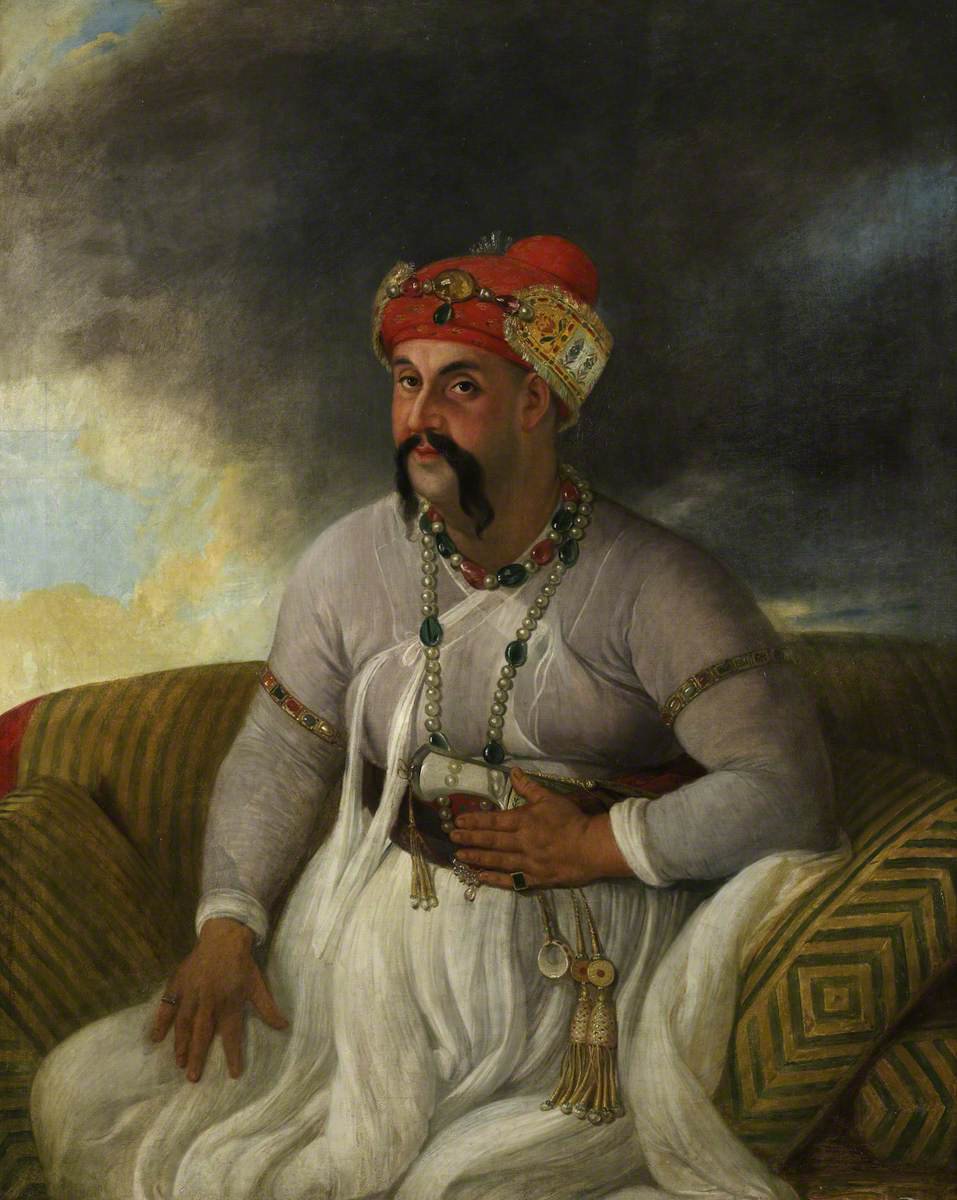
Portrait of Nawab Asaf-ud-Daulah (1775–1797) by Johann Zoffany (British Library) (source: https://twitter.com/worldoflucknow)
THE EXPANDING BRITISH EMPIRE – THREAT TO THE INDEPENDENCE OF AWADH
After defeating Nawab Siraj-ud-Daulah in the Battle of Plassey (1757) & conquering Bengal, the British made Mir Jafar, one of the conspirators, the puppet ruler of Bengal. Mir Jafar was followed by Mir Qassim, who tried to regain independence by forming an alliance with Shuja-ud-Daulah, the third Nawab of Awadh and Mughal emperor Shah Alam. The combined forces, however, lost badly against the British East India Company in the Battle of Buxar (1764). After that Awadh’s independence was also curtailed, to some extent, when the British appointed their representative (Resident General) in the court of Awadh.
THE BRITISH RESIDENCY
The construction of British Residency was started by Nawab Asaf-ud-daulah, the successor of Shuja-ud-Daulah, to house Sir Henry Lawrence, the then British Resident General in the court of Awadh. It was built over the period 1780 – 1800. The construction was completed by Nawab Sadat Ali Khan, the successor of Asaf-ud-Daulah. Today the Residency is in a completely dilapidated state and is the silent witness of the Sepoy Mutiny or India’s First War of Independence in 1857. Each & every brick of the ruined structures here speaks about the war fought, the valour shown and the pain suffered by the soldiers during the great uprise.
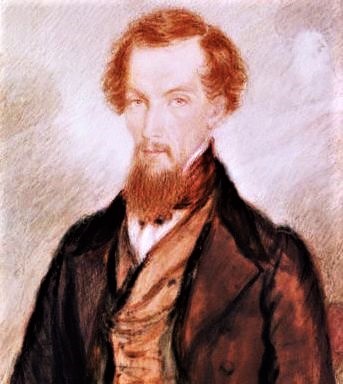
Portrait of Sir Henry Lawrence, National Portrait Gallery, London, Public Domain (source: https://commons.wikimedia.org/)
Over time, the British East India company forced a succession of treaties on the Nawabs of Awadh – each treaty contributed in curtailing the power of the Nawab & increasing the power of the Resident General. By 1800, the Resident General of Lucknow had become the quasi ruler of Awadh. Slowly the Residency also grew in size and turned into a British settlement sprawling over an area of 33 acres. In addition to Residence & Office of the Resident General, the massive complex included Treasury, School, Hospital, Post office, Banquet Hall, horse stables, sheep house, cemetery, gardens, parks and a Brigade Mess for the officers posted there. A ‘City within a City’, the Lucknow Residency became the political and administrative headquarters of British Awadh. The people of Lucknow, however, saw the Residency as a symbol of British oppression. In 1856, when Nawab Wajid Ali Shah was deposed and Awadh was annexed to the British Empire, the Residency became a subject of deep anger & hatred among the people of Lucknow.
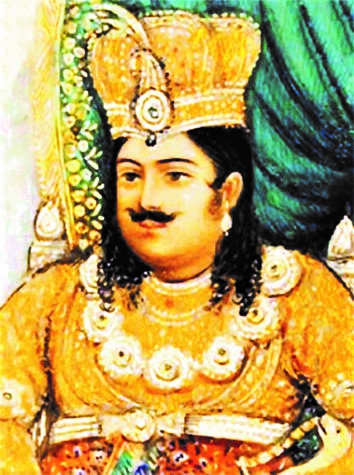
Portrait of Nawab Wajid Ali Shah (source: http://www.millenniumpost.in/)
INDIA’S FIRST WAR OF INDEPENDENCE & SIEGE OF LUCKNOW
In May 1857, the great mutiny broke out in Meerut followed by Delhi, Kanpur & other places in North India. Apprehending the situation, Sir Henry Lawrence, Resident General of Awadh, ordered all the Britishers in Lucknow to take refuge in the Residency. There were approx. 855 British officers & soldiers, 712 Indians and 1280 non-combatants inside the complex including around 50 school students and the Principal. Sufficient food and ammunition were also stored in the Residency.
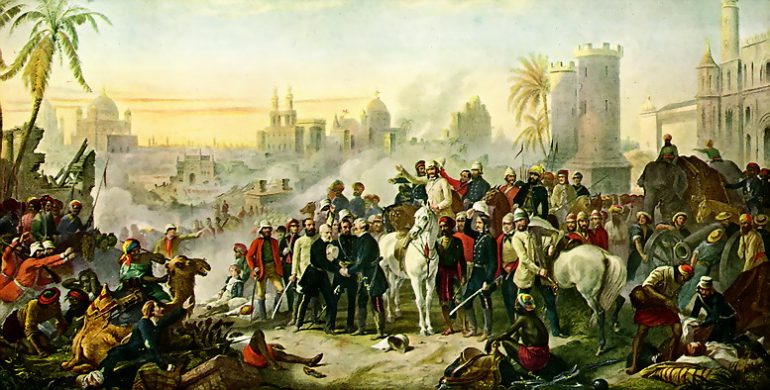
Portrait of Siege of Lucknow by Thomas Barker, 1914
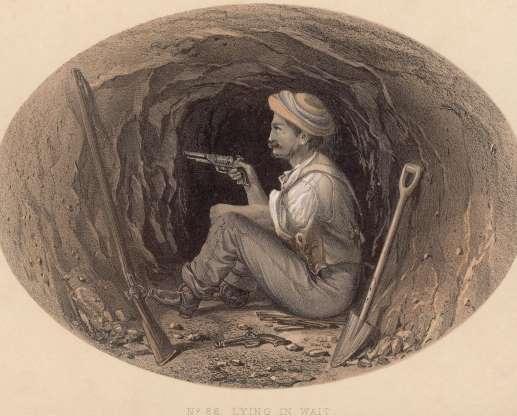
A British soldier waits to ambush rebels attempting to tunnel their way into the Residency during the Siege of Lucknow. 'Lying in Wait', an illustration from 'Sketches and Incidents of the Siege of Lucknow from Drawings made during the Siege by Clifford Henry Mecham, Lieutenant Madras Army'. (source: 50 stunning images from the Sepoy Mutiny of 1857, www.msn.com)
The rebellion finally reached Lucknow and around 8,000 Sepoy surrounded the Residency complex. This is known as the Siege of Lucknow that continued for almost 6 months (25th May to 27th Nov 1857). One of the key events during the initial days was that Lawrence got severely injured by a shell and died on 4th Jul 1857. Command passed to Colonel Inglis, who put up a formidable defence. The Sepoys were, however, indomitable. They started digging a tunnel to reach inside the compound and a fierce battle was fought with heavy casualties for both the sides. As days passed, food started to run short and casualties started to mount inside the Residency. After 87 days of the siege, General Henry Havelock and James Outram partially broke through the siege with a small army of 1000 soldiers. However, Havelock's force was insufficient and Lucknow was once again surrounded until 25th Nov 1857 when General Collin Campbell arrived with a larger force relieving the inhabitants out of the Residency. The Residency along with the city of Lucknow were given up to the mutineers.
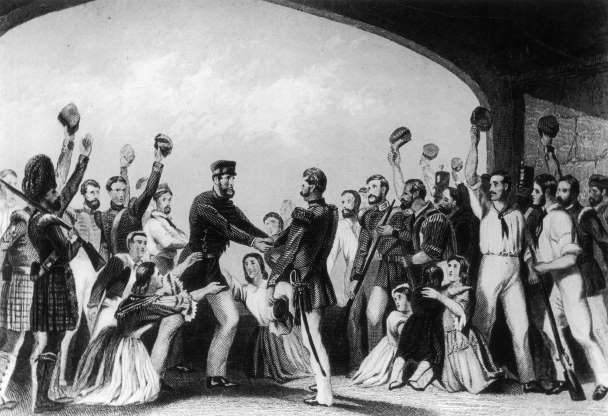
The First Relief after 87 days - General Henry Havelock and his troops relieving the besieged English at Lucknow Residency, 25th Sep 1857. (source: 50 stunning images from the Sepoy Mutiny of 1857, www.msn.com)
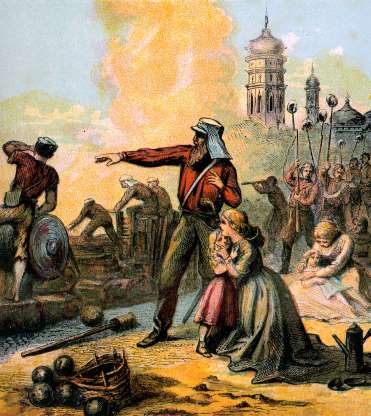
The Final Relief after another 61 days - General Colin Campbell arrived with a larger force on 25th Nov 1857 to finally relieve the besieged. ‘The Relief of Lucknow’, a colour plate taken from ‘Pictures of English History’, George Routledge & Sons (London, New York, c1850). (source: 50 stunning images from the Sepoy Mutiny of 1857, www.msn.com)
The following year, the British army recaptured the city of Lucknow with the help of the Gurkha troops from Nepal. The recapture of Lucknow by the British from the mutineers was followed by mass slaughter, loot and destruction (that’s what the British did in all the places they recaptured). The British treated the mutineers with utmost cruelty to ensure that such a revolt would never occur in future. Several people were killed with bayonets or were blown up with cannons. Large parts of the Lucknow city were simply pulled down. Several buildings & structures were demolished and looted including Kaiser Bagh palace (the palace of Wajid Ali Shah).
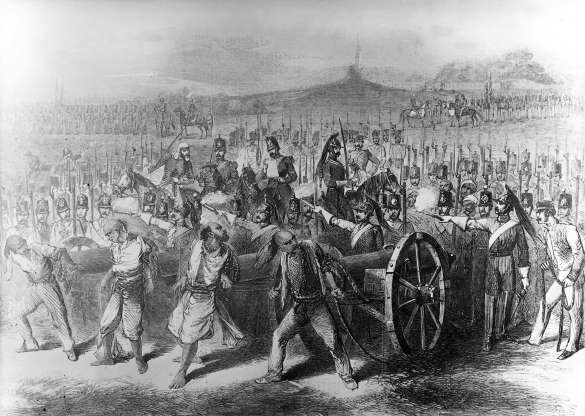
The execution of the rebels by cannons. (source: 50 stunning images from the Sepoy Mutiny of 1857, www.msn.com)
With that the grandiosity of Lucknow faded. The city that the contemporary visitors used to compare with Vienna & Paris, could never regain its lost beauty. The Residency was also never rebuilt. It has been maintained as it was at the time of the final relief. Ever since Indian Independence, little has changed. Today the ‘Ruins of British Residency’ is a famous historical landmark in Lucknow and has been declared as a Monument of National Importance by the Archaeological Survey of India.
Read full travelogue on Lucknow: Constantinople of India: Exploring the Historical City of Lucknow
“Let’s take a tour of the Residency, walk back into history & fathom those momentous events that took place here during the Great Revolution of 1857.”
PRESENT-DAY LUCKNOW RESIDENCY: A PHOTO TOUR THROUGH THE RUINS
Today, when you visit the Residency, you can observe the ruins of several buildings surrounded by lawns and flowerbeds: The Main Building, the Banquet Hall, Dr. Fayrer’s House, Begam Kothi, the Mosque, the war cemetery etc. - all these have been maintained as it was in 1857. While roaming around you will notice the cannonball marks on the walls of the structures. There is also the 1857 Memorial Museum, which is a must-see.
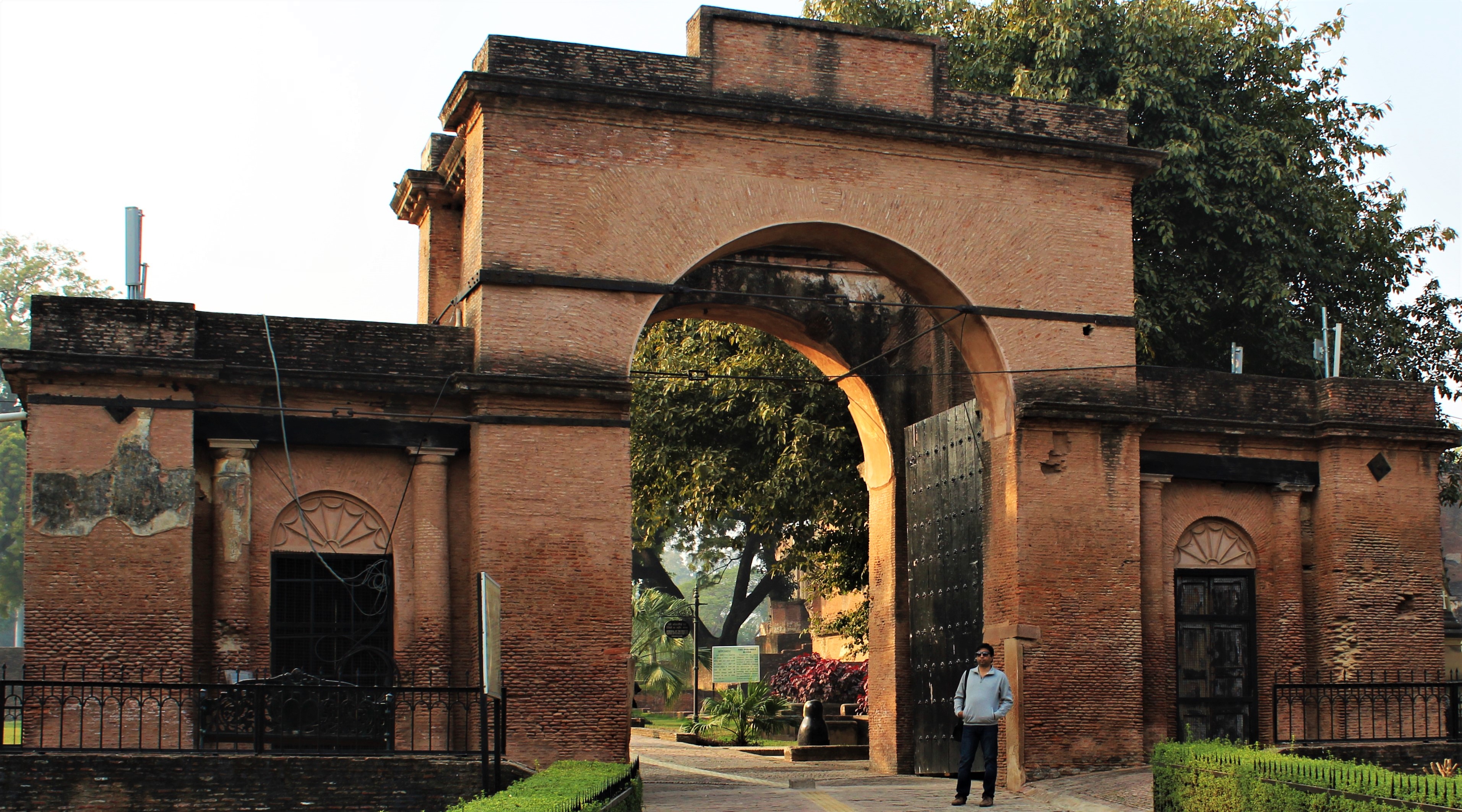
BAILLEY GUARD GATE: The entrance gate to the Residency was constructed by Nawab Saadat Ali Khan in the honour of Capt. John Bailley, who became the Resident of Lucknow in the beginning of 19th century and since then it is known as Bailley Guard Gate.
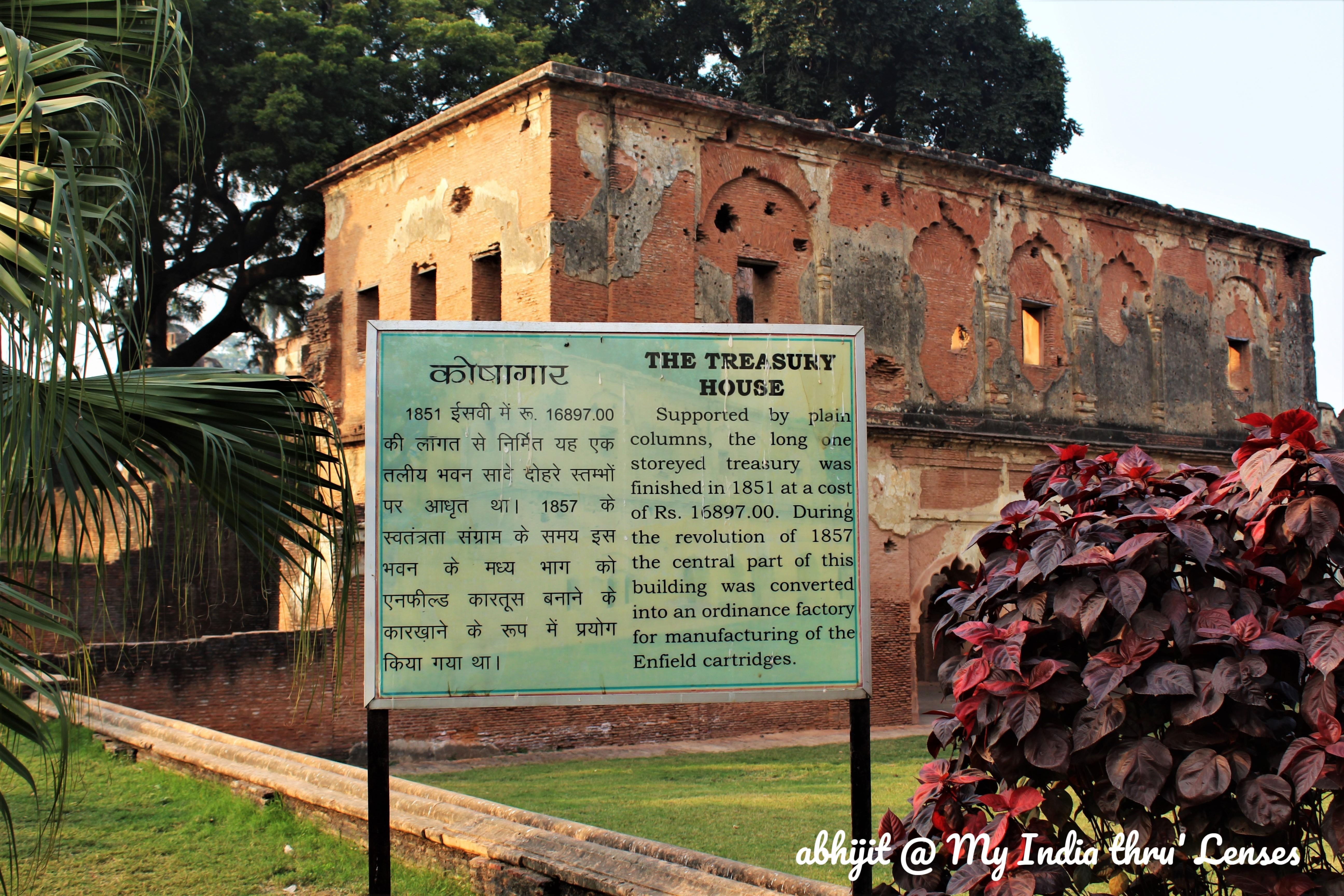
THE TREASURY HOUSE: The rooms of this building were used for various purposes, such as, treasury, store room and also as the barrack of the 13th Native Infantry & their commander. During the revolution of 1857 the long room at the centre of the building was used for making Enfield Cartridges.
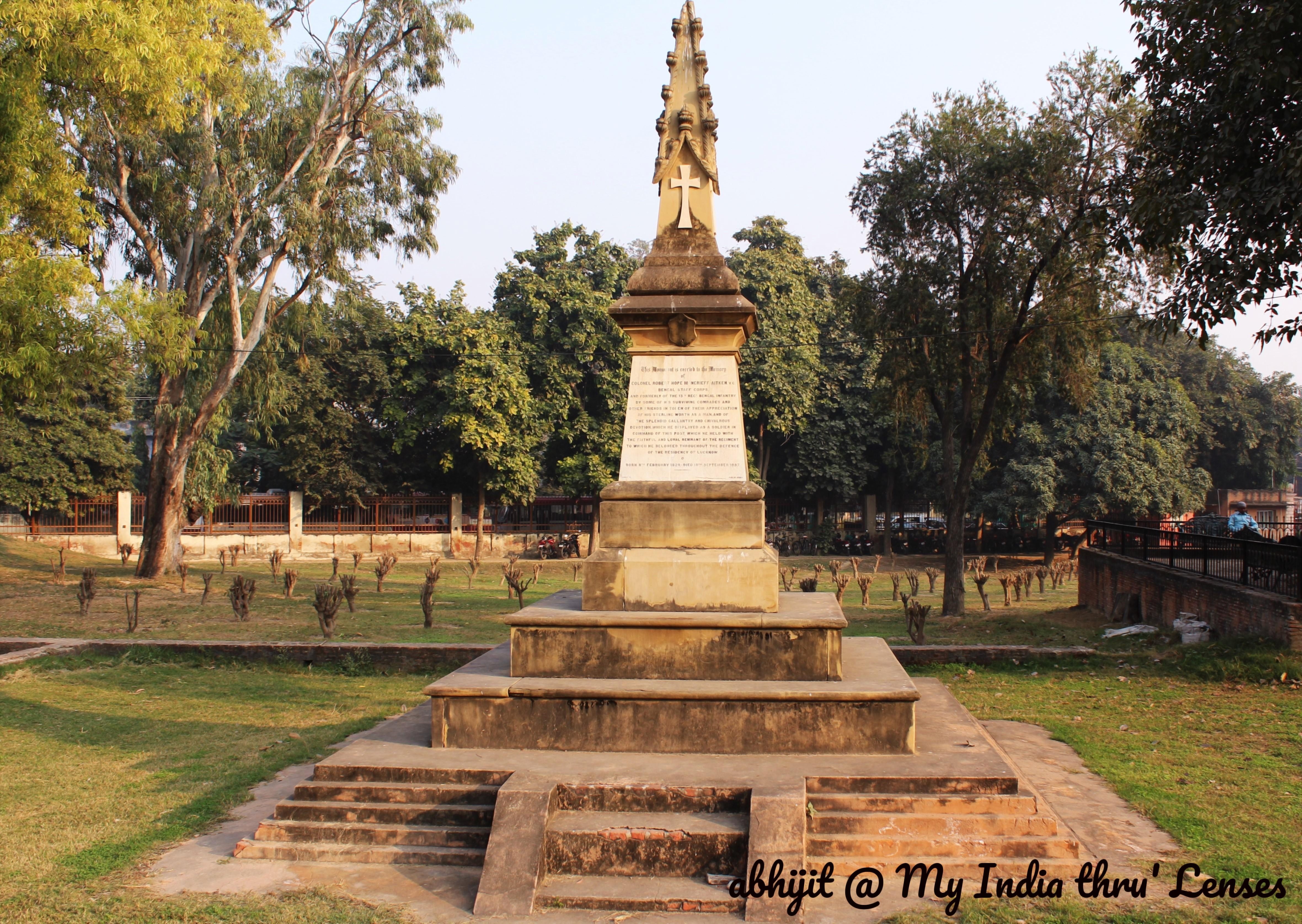
MEMORY OF THE NATIVE OFFICERS AND SEPOYS: This is situated just in front of the Treasury and you will find it towards your right when you enter through the Bailey Guard Gate. It is inscribed in three languages and now sadly defaced. The inscription reads as:
“To the Memory of the Native Officers and Sepoys of the 13th Native Infantry, 41st Native Infantry, 488th Native Infantry, 71st Native Infantry, the Oude Irregular Force, Native Pensioners, New Native Levies, Artillery, and Lucknow Magazine who died near this spot nobly performing their duty.”
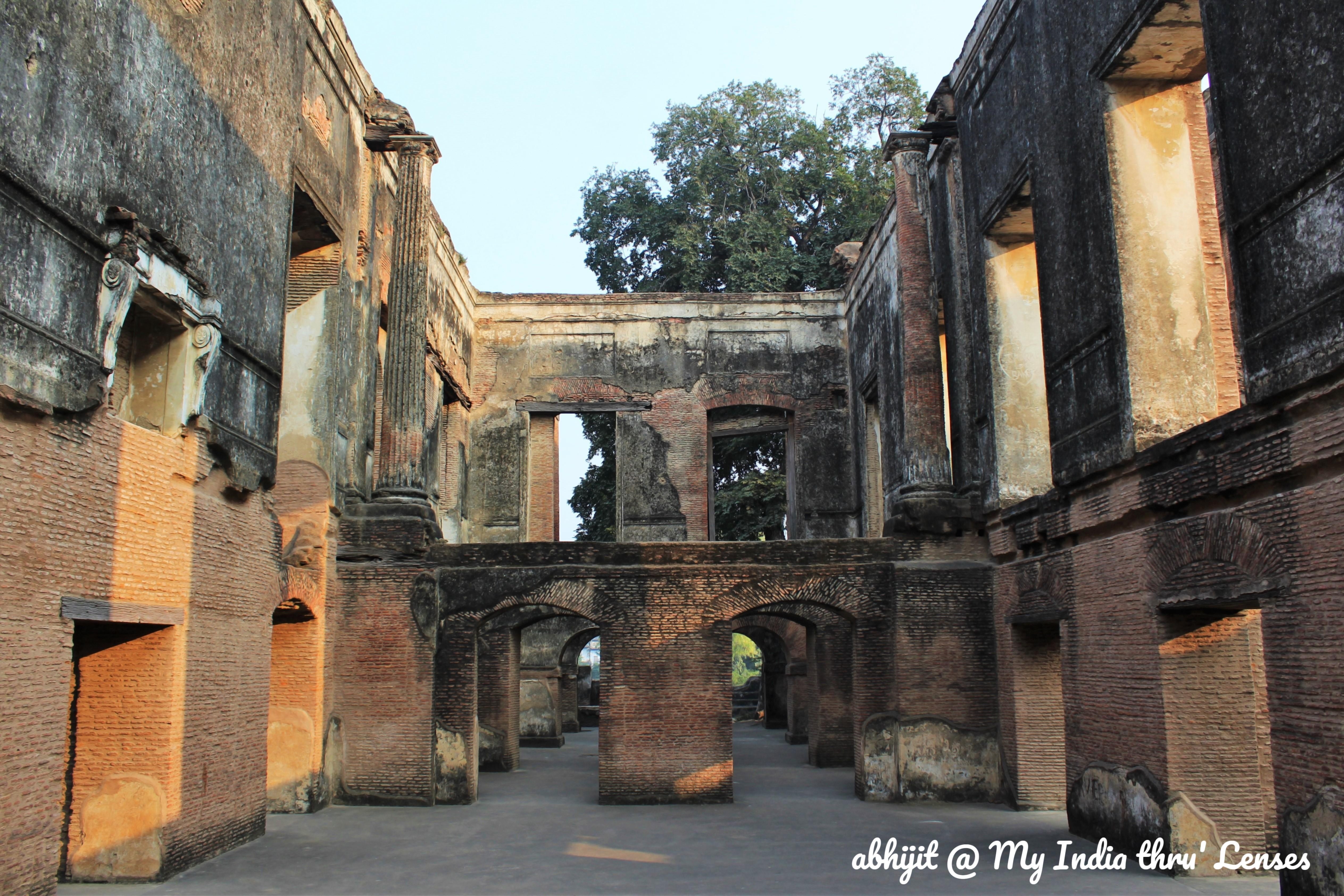
THE BANQUET HALL: Constructed by Nawab Saadat Ali Khan, the Banquet Hall was one of the most imposing structure with its grand apartments & spacious saloons. The hall used to be furnished with costly chandeliers, mirrors & other high-quality furniture. It was used for banquets in the honour of Nawab. A stucco fire place at the first-floor level still retains a marble-like finish. A broken fountain in the main entrance hall exhibits an example of decorated marble work in black & white.

DR. FAYRER’S HOUSE: It was the house of Dr. Fayrer, who was Resident Surgeon during the siege of 1857. Sir Henry Lawrence was shifted to this building after being mortally wounded on 2nd July who succumbed to his injuries on 4th July 1857.
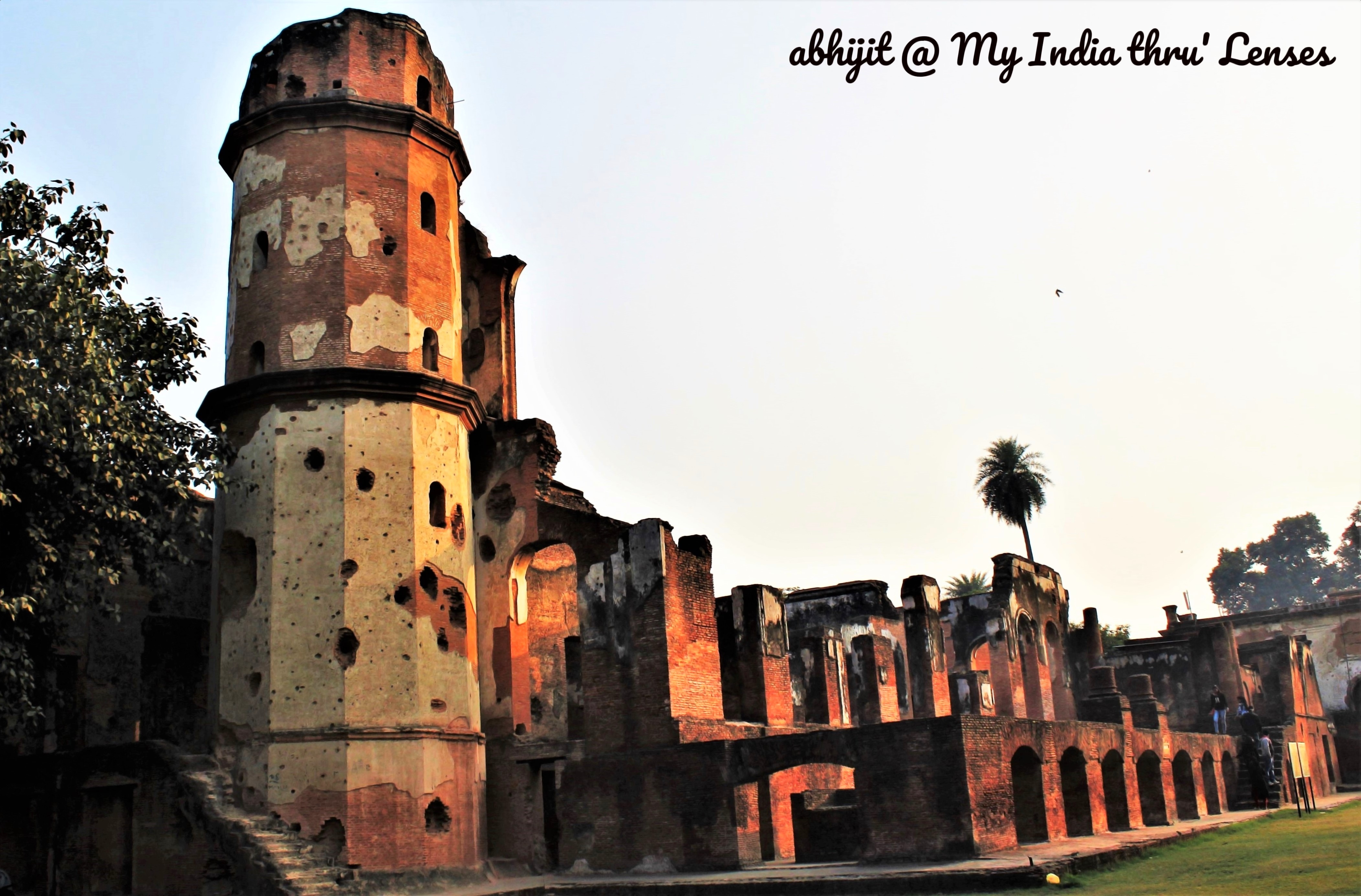
RESIDENCY MAIN BUILDING: Originally it was a 3-storeyed imposing building meant for the British Resident. Towards the eastern side, there was the principal entrance under a beautiful portico and along the west, there was a wide & lofty colonnaded verandah. Spiral stairs inside two turrets on the north & south sides led to the roof. There were numerous lofty windows in this building and the roof was protected with Italian bars. There were underground rooms in the southern part of the building to provide an effective shield against hot winds of Lucknow summer.
During the siege of 1857, European ladies and children had taken shelter in these underground rooms. Miss Susanna Palmer, daughter of Col. Palmer was killed in the annexe building and Henry Lawrence was mortally wounded when he was sitting in the library. The annexe building, which formerly used to be a model room now houses “1857 Memorial Museum”. Numerous cannon ball marks can be seen on the walls of the Main Building reflecting the fierce battle fought here during the siege.

1857 MEMORIAL MUSEUM: The Museum is set up in the annex of the Main Residency Building to highlight the struggle of the people of India and also the role played by the people of Lucknow (one of the epicentres of the uprise) during India’s first war of Independence. It is currently maintained by Archaeological Survey of India and is spread over the ground floor & the basement area of the building - there are 4 galleries on the ground floor and 7 in the basement.

Inside the museum, the exhibits are systematically & chronologically arranged to offer a lucid account of India’s First War of Independence. These exhibits include artefacts discovered from the excavation of the Residency, porcelain items, wine bottles, important documents, photographs, paintings, lithographs, shields, various weapons including cannons, cannon balls & guns, badges and a multitude of other important memorabilia. There are several maps and a big model of the Residency.


FROM THE GALLERIES OF THE 1857 MEMORIAL MUSEUM. TOP: A Painting of the Residency Main Building as it was before the siege. BOTTOM: A Painting of the Rumi Darwaza prior to 1857.


MORE FROM THE GALLERIES OF THE MUSEUM. TOP: Model of Residency displayed in one of the galleries. BOTTOM: Portraits inside the Museum

A cannon ball mark in one of the inner walls of the Museum. Fired from outside, the cannon ball probably entered the room through the big window on the left killing the insiders.

SIR HENRY LAWRENCE MEMORIAL: High Cross and Memorial of Resident General Sir Henry Montgomery Lawrence (28.06.1806 – 04.07.1857), who was mortally wounded on 2nd July and succumbed to his injuries on 4th July 1857.

BEGUM KOTHI: The Begum Kothi (Lady's Quarters) was a large, imposing building with a lofty gateway. It consisted of two ranges of buildings, the inner buildings & the surrounding outer buildings forming a square within a square. There was an Imambara on one side. An upper room of the Begum Kothi served as the store-room. There is also one adjacent house that is today labelled as the Kitchen. It was the house of Mr. Quieros, which along with its adjoining stables was utilised as a canteen cum liquor store-room. The house was connected to the Begum Kothi by a passageway.

The Mosque
There are certain other points, which you may also visit, such as, the Sheep House, the Slaughter House, the Bungalow, the Mosque & Imambara and the Cemetery. Finally, do spend some time roaming around or relaxing on a bench within the Residency complex – the tall trees, the lush green lawns and the sunlight falling on the dilapidated brick structures will take you back, for a while, to 1857.

Site Plan of the Lucknow Residency
INFORMATION FOR THE TOURISTS
- Address: Mahatma Gandhi Marg, Deep Manak Nagar, Kaiser Bagh, Lucknow, Uttar Pradesh 226001, India
- Online Info: UP Tourism
- Online Ticket booking is now possible through Yatra Website: Book Ticket Online
- Entry Timings: 10 am to 5 pm. Monday Closed. (Keeps on changing, please do check the website before visit).
- Entry Fee: INR 15 (Indian), INR 200 (Foreigner). Camera allowed.
- Approx. duration to complete the visit: 3 hours

REFERENCES
- Indian Rebellion of 1857: Siege of Lucknow (https://www.thoughtco.com/indian-rebellion-1857-siege-of-lucknow-2361380)
- Wikipedia (https://en.wikipedia.org/wiki/Siege_of_Lucknow)
- The Fall of Lucknow, Krutika Haraniya, Live History India (www.livehistoryindia.com/amazing-india/2018/01/06/the-fall-of-lucknow)
- Siege of Lucknow, The Social Historian (https://www.thesocialhistorian.com/siege-of-lucknow/)
Photographs, unless otherwise credited, are self-captured.
Read full travelogue on Lucknow: Constantinople of India: Exploring the Historical City of Lucknow
Good Research. Lucid Language. However, if you are interested about original findings on Lucknow, contact Ms Manzilat Fatima, who is the great-great grand daughter of Nawab Wajid Shah. She runs a restaurant in Kolkata.